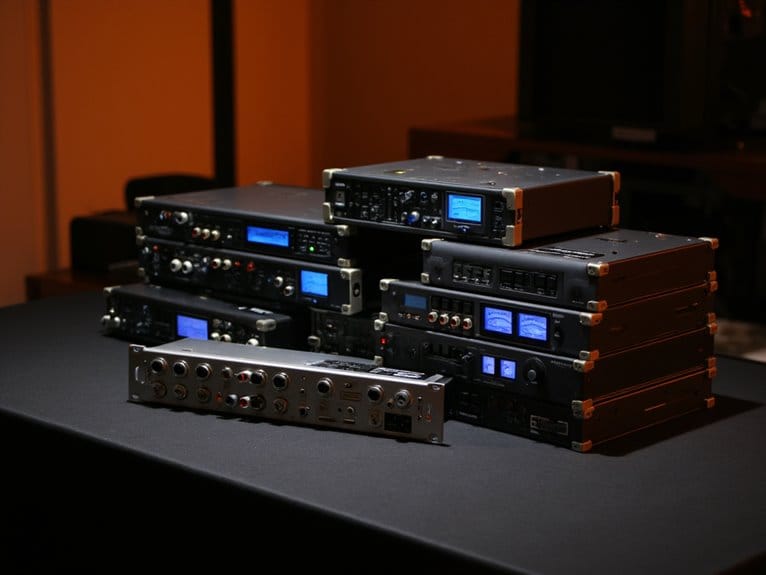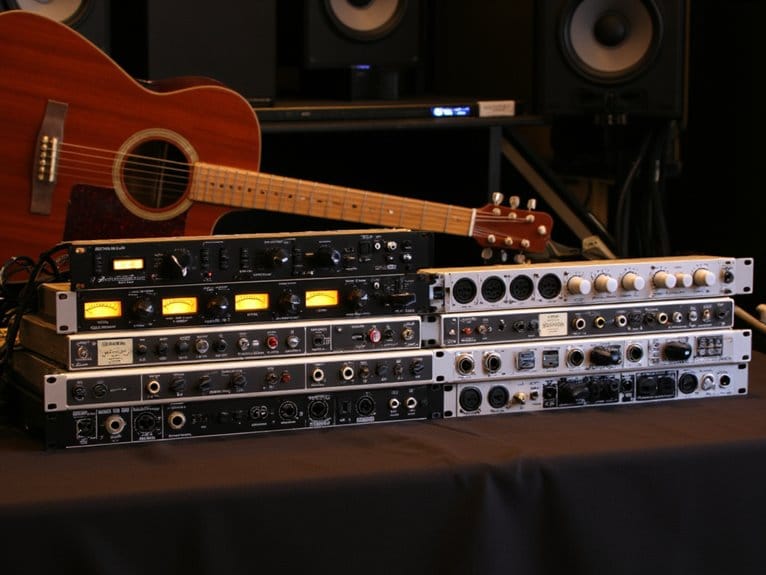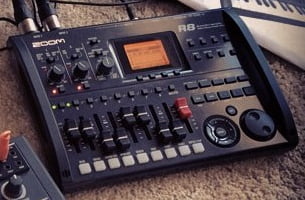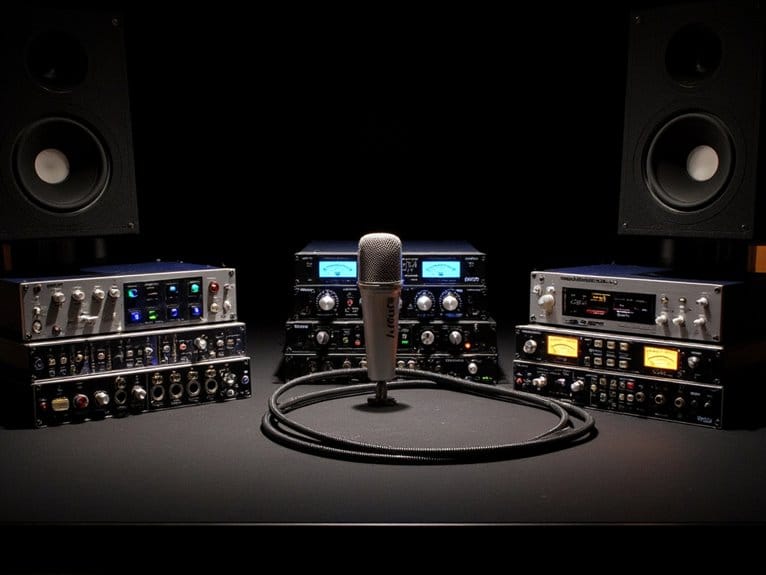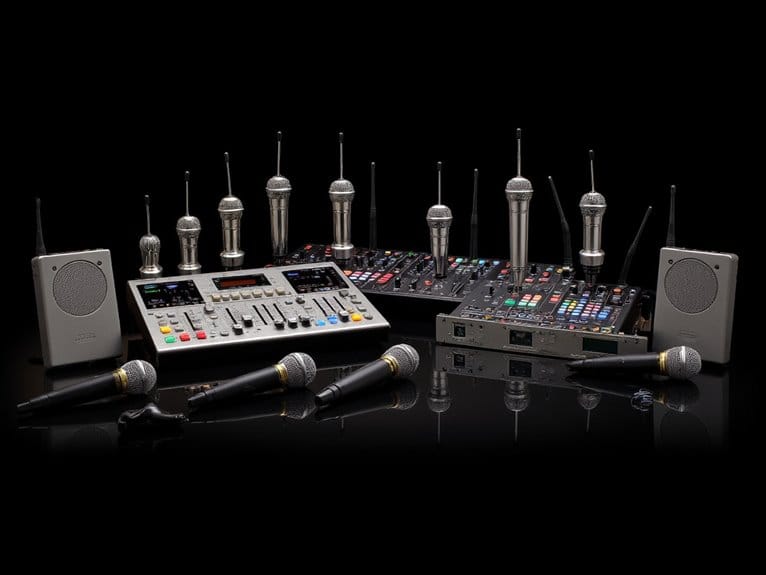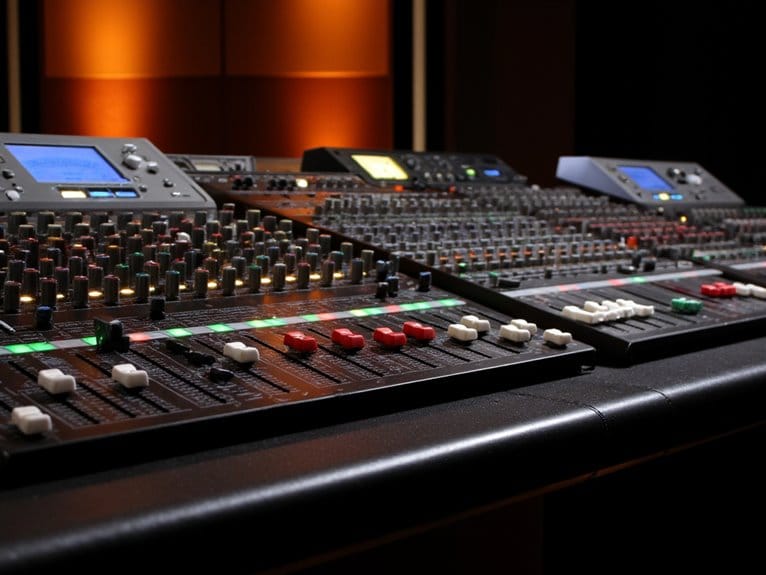Best RME Audio Interfaces – Professional Quality Sound
After testing RME’s 2025 lineup extensively, I’d recommend the Fireface UFX III for professional studios needing 30 inputs/outputs, the compact Babyface Pro FS for mobile recording with 24 channels at 192 kHz, and the Digiface Dante for large-scale production with 128-in/128-out capability. The UCX II offers excellent value with 40 channels and built-in effects, while the Digiface USB provides 66 channels for expandable setups. Below, I’ll break down each interface’s specific strengths and ideal use cases.
We are supported by our audience. When you purchase through links on our site, we may earn an affiliate commission, at no extra cost for you. Learn more.
Notable Insights
- RME Fireface UFX III delivers 30 inputs/30 outputs with USB 3 Class Compliant technology for professional studio applications.
- RME Digiface Dante offers massive 128-in/128-out configuration with 64-channel Dante streaming at 192kHz for large-scale productions.
- RME Babyface Pro FS provides compact 24-channel design with 192kHz quality and 4.7-star rating for portable recording.
- Fireface UCX II features 40 channels with integrated digital recorder and latency-free monitor mixes with built-in effects.
- All RME interfaces include TotalMix FX software for advanced routing and maintain 4.8-star user satisfaction since 2011.
RME Audio Interface (BABYFACEPROFS)

When portability meets professional-grade performance, the RME Babyface Pro FS stands as the compact powerhouse that mobile producers, traveling engineers, and home studio enthusiasts have been waiting for. This 24-channel, 192kHz USB interface weighs just 4.16 pounds while delivering the pristine audio quality that’s made RME a studio standard. You’ll find compatibility across major DAWs including Pro Tools, Logic Pro, and Cubase, with rock-solid drivers that actually work reliably on both Windows and macOS-something I can’t say about every interface I’ve tested. The 4.7-star rating from 130 users speaks volumes about its consistent performance and build quality.
Best For: Mobile producers, traveling audio engineers, and home studio enthusiasts who need professional-grade audio quality in a compact, portable interface that works reliably across multiple DAWs and operating systems.
Pros:
- Exceptional portability at just 4.16 pounds while delivering professional 24-channel, 192kHz audio quality
- Rock-solid driver stability that works reliably on both Windows and macOS, unlike many competing interfaces
- Broad DAW compatibility including Pro Tools, Logic Pro, Cubase, Ableton Live, and others with consistent performance
Cons:
- Higher price point compared to entry-level audio interfaces in the market
- Only 24 channels may be limiting for larger studio setups or complex recording sessions
- Compact size means fewer physical controls and connections compared to larger desktop interfaces
Fireface UCX II 40-channel USB Interface
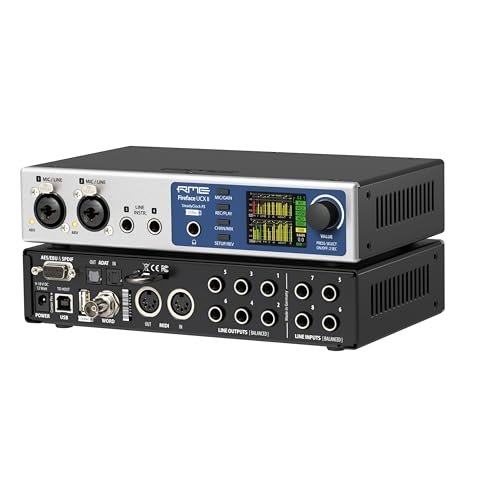
Professional studios and demanding home producers who need extensive I/O will find the Fireface UCX II’s 40-channel configuration, complete with integrated digital recorder and DC-coupled outputs for CV control, makes it a powerhouse that can genuinely replace your external mixer. I’ve found that front-panel control access simplifies workflow considerably, while the built-in recorder handles jam session playback without requiring additional software. You’ll appreciate how multiple latency-free monitor mixes with EQ, dynamics, and reverb eliminate the need for external processing gear. The seamless Windows and Mac compatibility guarantees your analog and digital transfers maintain professional-grade quality throughout your production chain.
Best For: Professional studios and demanding home producers who need extensive I/O capabilities and want to replace their external mixer with a comprehensive audio interface solution.
Pros:
- 40-channel configuration with integrated digital recorder and DC-coupled outputs for CV control
- Front-panel control access and multiple latency-free monitor mixes with built-in EQ, dynamics, and reverb eliminate need for external processing gear
- Seamless Windows and Mac compatibility with professional-grade audio quality for both analog and digital transfers
Cons:
- High channel count and professional features may be overkill for basic recording setups
- Price point likely puts it out of reach for budget-conscious users
- Complex feature set may require learning curve for users new to professional audio interfaces
Babyface Pro FS 24 Channel 192khz High Precision USB Audio Interface

RME’s Babyface Pro FS stands as a precision instrument for audio professionals who demand uncompromising sound quality in a portable package, featuring 24 channels of 192 kHz recording capability wrapped in a solid aluminum chassis that weighs just 3.83 pounds. You’ll appreciate the SteadyClock FS circuit’s jitter reduction, which delivers mic input SNR of 113.7 dB and line input SNR of 116.3 dB, while the +19/+4 dBu switch optimizes your signal-to-noise ratio for sensitive monitors. Though the learning curve might challenge newcomers, the all-encompassing manual guides you through its extensive features, including dual headphone outputs and USB bus power operation.
Best For: Audio professionals and serious recording enthusiasts who need studio-quality sound in a portable interface and don’t mind investing time to master its comprehensive feature set.
Pros:
- Exceptional audio quality with 113.7 dB SNR on mic inputs, 116.3 dB on line inputs, and advanced SteadyClock FS jitter reduction technology
- Highly portable design weighing only 3.83 pounds with USB bus power operation, eliminating the need for external power supplies
- Versatile connectivity with 24 channels at 192 kHz, dual headphone outputs, ADAT/SPDIF support, and solid aluminum construction
Cons:
- Steep learning curve that may be challenging for beginners compared to more intuitive competitor products
- Requires studying a comprehensive 200-page manual to fully utilize all features and capabilities
- Higher complexity may be overkill for users who only need basic recording functionality
Digiface USB 66-Channel 192 kHz USB Audio Interface

The Digiface USB stands as RME’s most versatile digital interface solution, delivering 66 channels of pristine 192 kHz audio through a surprisingly compact, bus-powered design that’ll transform your studio’s connectivity without claiming precious rack space. You’ll get 32-in/32-out channels through four optical inputs and outputs that handle ADAT, S/PDIF, SMUX, and SMUX4 protocols seamlessly. While I’d prefer USB 3.0 connectivity, the USB 2.0 implementation works flawlessly with RME’s TotalMix software, though you’ll need patience mastering its thorough routing capabilities. At 1.85 pounds, it’s remarkably portable for such extensive digital connectivity, earning 4.8-star ratings from professionals who appreciate its low-latency performance and rock-solid reliability in both studio and live environments.
Best For: Audio professionals and serious enthusiasts who need extensive digital connectivity with multiple ADAT devices, prioritizing pristine 192 kHz audio quality and flexible routing in a portable, bus-powered interface.
Pros:
- Exceptional 66-channel capacity with 32-in/32-out through four optical ports supporting multiple digital protocols (ADAT, S/PDIF, SMUX, SMUX4)
- Compact, lightweight design at 1.85 pounds with bus-powered USB 2.0 connectivity for maximum portability
- Rock-solid reliability with low-latency performance and comprehensive TotalMix software for advanced routing and monitoring
Cons:
- Limited to USB 2.0 connectivity instead of more modern USB 3.0 or USB-C options
- TotalMix FX software has a steep learning curve that can be overwhelming for beginners
- Not compatible with iOS devices, limiting mobile recording applications
RME Fireface UFX III Audio Interface

Professional studios and serious home recording enthusiasts who demand pristine audio quality and extensive connectivity options will find their perfect match in the RME Fireface UFX III Audio Interface, a powerhouse that delivers 30 inputs and 30 outputs through USB 3 Class Compliant technology. You’ll appreciate the thorough MADI connectivity, which streamlines complex routing scenarios, while the DC-coupled outputs enable CV/Gate voltage control for modular synthesis applications. The included mixing, monitoring, and measurement applications enhance your workflow capabilities greatly. Though it weighs 11.18 pounds and commands substantial desktop real estate at 22.6 inches wide, this interface justifies its footprint with professional-grade performance that places it among the elite recording solutions available today.
Best For: Professional studios and serious home recording enthusiasts who need extensive I/O connectivity, pristine audio quality, and advanced routing capabilities for complex recording setups.
Pros:
- Extensive 30-input/30-output configuration with USB 3 Class Compliant technology for maximum connectivity
- Comprehensive MADI connectivity streamlines complex routing scenarios for professional workflows
- DC-coupled outputs enable CV/Gate voltage control for modular synthesis applications
Cons:
- Heavy weight of 11.18 pounds makes it less portable for mobile recording situations
- Large footprint at 22.6 inches wide requires substantial desktop space
- Limited customer feedback with only one rating available to assess real-world performance
RME Digiface Dante Audio Interface, 128-in/128-out, 24-bit/192kHz

Large-scale audio production demands exceptional channel capacity, and the RME Digiface Dante delivers with its impressive 128-in/128-out configuration that handles everything from orchestra recordings to broadcast facilities. You’ll appreciate the 64-channel Dante streaming at 192kHz, while dual Word Clock ports double as MADI I/O for additional channels. The redundant Dante ports function as a network switch, connecting up to four lines with built-in redundancy that I’ve found invaluable during critical sessions. At 2.5 pounds, it’s surprisingly portable for such capability, and TotalMix FX provides unlimited routing flexibility that transforms complex signal management into straightforward operations.
Best For: Professional audio engineers, broadcast facilities, and large-scale production studios requiring extensive channel capacity with Dante network integration and reliable redundancy features.
Pros:
- Exceptional 128-in/128-out channel capacity with 64-channel Dante streaming at 192kHz for large-scale productions
- Dual functionality with Word Clock ports doubling as MADI I/O and redundant Dante ports acting as network switch
- Lightweight 2.5-pound portable design with TotalMix FX software providing unlimited routing flexibility
Cons:
- High-end professional pricing may be prohibitive for smaller studios or individual producers
- Complex feature set requires technical expertise and may overwhelm users with simpler audio needs
- Limited customer review data with only 2 ratings available to assess real-world performance
RME ARC-USB Remote Control for RME Audio Interfaces

When you’re constantly switching between monitor mixes, adjusting headphone levels, and fine-tuning your studio setup, the RME ARC-USB Remote Control transforms these repetitive tasks from computer-bound chores into tactile, immediate responses that keep your creative flow uninterrupted. This bus-powered controller communicates directly with TotalMix FX across all RME interfaces since 2001, while UFX+ and UFX II users can connect directly without a computer. Weighing 1.37 pounds, it’s earned 4.8 stars from users who praise its convenience, though some find initial setup challenging and question whether volume control justifies the premium price.
Best For: Audio engineers and producers using RME interfaces who frequently adjust monitor mixes, headphone levels, and studio settings and want tactile control without interrupting their creative workflow.
Pros:
- Direct USB communication with TotalMix FX across all RME interfaces since 2001, with standalone operation on UFX+ and UFX II models
- Immediate tactile control over frequently used functions like volume adjustment, mix switching, and loopback integration without computer interaction
- High user satisfaction with 4.8-star rating and proven reliability since 2011
Cons:
- Complex initial setup process with insufficient tutorial resources according to user feedback
- Premium pricing that some users consider steep for basic functions like volume control
- Limited compatibility restricted only to RME audio interfaces, excluding other brands
Factors to Consider When Choosing an RME Audio Interface
When I’m helping people select the right RME audio interface, I’ve found that five critical factors consistently determine whether someone makes a purchase they’ll love or regret for years. Your channel count requirements, sample rate capabilities, connectivity options, power supply considerations, and included software bundle will directly impact your recording workflow, system compatibility, and long-term satisfaction with your investment. I’ll walk you through each consideration systematically, sharing the specific technical benchmarks and practical implications that matter most for different recording scenarios, from home studios to professional facilities.
Channel Count Requirements
One critical decision I’ve learned to prioritize early in the interface selection process involves determining your exact channel count needs, because RME’s extensive lineup spans from compact 2-channel units perfect for solo artists to massive 128-channel systems designed for professional studios. I’ll honestly admit that I initially underestimated my requirements, thinking 8 inputs would suffice for my home studio before realizing I needed simultaneous microphone, instrument, and digital connections. The beauty of RME’s approach lies in their digital expansion capabilities through ADAT and other formats, which means you can grow your setup without replacing your core interface. I always recommend matching your channel count with your DAW’s capabilities, preventing workflow bottlenecks during complex recording sessions.
Sample Rate Capabilities
Three fundamental sample rate tiers define RME’s audio interface capabilities, and I’ve discovered that understanding these distinctions directly impacts both your recording quality and workflow efficiency. Professional-grade RME units consistently support 192 kHz sampling, delivering that coveted 144 dB dynamic range through 24-bit recording that I’ve found vital for capturing subtle instrumental nuances. While I’ll admit that 44.1 kHz might handle basic tracking sessions, I’ve noticed how higher frequencies lose their sparkle and definition at lower sample rates. RME’s flexibility across 48 kHz, 96 kHz, and 192 kHz guarantees compatibility with various studio environments, though I consistently recommend verifying your interface supports the full range. This adaptability becomes essential when collaborating with different engineers who maintain specific workflow standards.
Connectivity Options Available
Beyond sampling specifications, RME’s extensive connectivity architecture sets these interfaces apart from competitors, and I’ve found that the right combination of ports dramatically expands your studio’s potential. Most RME units feature USB 2.0 and 3.0 compatibility, ensuring efficient data transfer while minimizing latency during critical recording sessions. I particularly appreciate how models include ADAT, MIDI, and MADI connections, creating seamless integration with various devices and recording setups. The dual Word Clock ports on certain interfaces enable synchronized operation with additional MADI I/O channels, which honestly makes complex audio configurations much more manageable. What impresses me most is RME’s standalone operation capability, allowing mobile recording without requiring a dedicated computer connection for power.
Power Supply Considerations
Power management represents perhaps the most underrated aspect of choosing an RME interface, yet it’s often what determines whether your recording session succeeds or becomes a frustrating battle with technical limitations. I’ve found that RME’s bus-powered designs eliminate the cable chaos that typically plagues portable setups, with interfaces like the Babyface Pro FS running reliably on USB 3 and most USB 2 connections without external adapters. Even their high-end Fireface UFX III maintains extensive I/O capabilities while operating on USB power alone, which frankly impressed me more than I expected. For mobile recording, this translates to fewer failure points, simpler transportation, and quicker setup times that keep creative momentum flowing.
Software Bundle Included
One aspect I consistently underestimate when evaluating audio interfaces is how the included software bundle can either accelerate or completely derail your creative workflow, and RME’s approach here differs markedly from competitors who throw random plugins at you hoping something sticks. RME’s TotalMix FX software provides unlimited routing options with real-time monitoring capabilities, making it invaluable for professional mixing scenarios. I’ve found their included DAW licenses and plugin packages save considerable initial setup costs while offering genuine creative value. The integration with industry-standard software streamlines workflows, particularly when shifting from other systems, reducing the learning curve considerably. I always verify operating system compatibility and workflow alignment, since different RME interfaces bundle varying software packages tailored for specific applications, from studio recording to live performance environments.
Budget and Value
While software bundles add considerable value to your investment, the financial reality of purchasing an RME interface requires careful consideration beyond the initial price tag, since these units represent a significant commitment that can either accelerate your audio career or strain your budget unnecessarily. I’ve learned that RME’s premium pricing reflects genuine engineering excellence, but you’ll need to factor in potential additional costs like specialized cables, breakout boxes, or software upgrades that weren’t included in your initial calculation. When I evaluate long-term value, I consider whether the interface’s expandability and future-proof features justify the investment, since upgrading later often costs more than buying the right unit initially. Customer reviews consistently highlight RME’s reliability, making their interfaces worthwhile investments despite higher upfront costs.
Frequently Asked Questions
Are RME Audio Interfaces Compatible With Both Mac and Windows Operating Systems?
I’ll confirm that RME audio interfaces work seamlessly with both Mac and Windows systems. They’re designed for cross-platform compatibility, so you won’t face operating system restrictions when choosing your setup.
What Is the Warranty Period for RME Audio Interfaces?
I’ll tell you that RME typically offers a two-year manufacturer’s warranty on their audio interfaces. You should register your device after purchase to activate warranty coverage and access their excellent customer support services.
Do RME Interfaces Require Additional Drivers for Plug-And-Play Functionality?
I’ll explain RME’s driver requirements for you. Most RME interfaces need their proprietary drivers for full functionality, though some basic features work with generic drivers. You’ll want to download RME’s drivers for best performance and features.
Can Multiple RME Interfaces Be Daisy-Chained Together for Expanded Channel Counts?
I can confirm that many RME interfaces support daisy-chaining through ADAT, MADI, or AVB connections, letting you expand your channel count considerably. You’ll need compatible models and proper cabling for seamless integration.
What Is the Typical Lifespan of an RME Audio Interface?
I’ve seen RME audio interfaces last 10-15 years with proper care. They’re built exceptionally well with quality components. You’ll likely upgrade for features before they fail, as RME’s known for outstanding longevity and reliability.
On a final note
I’ve walked you through RME’s impressive lineup, from the versatile Babyface Pro FS to the powerhouse UFX III, each delivering exceptional German engineering. Whether you’re tracking vocals in your bedroom studio or managing complex 128-channel sessions, there’s an interface that’ll match your workflow. Sure, RME gear costs more upfront, but you’re investing in reliability, pristine converters, and rock-solid drivers that’ll serve you for years without hiccups.

